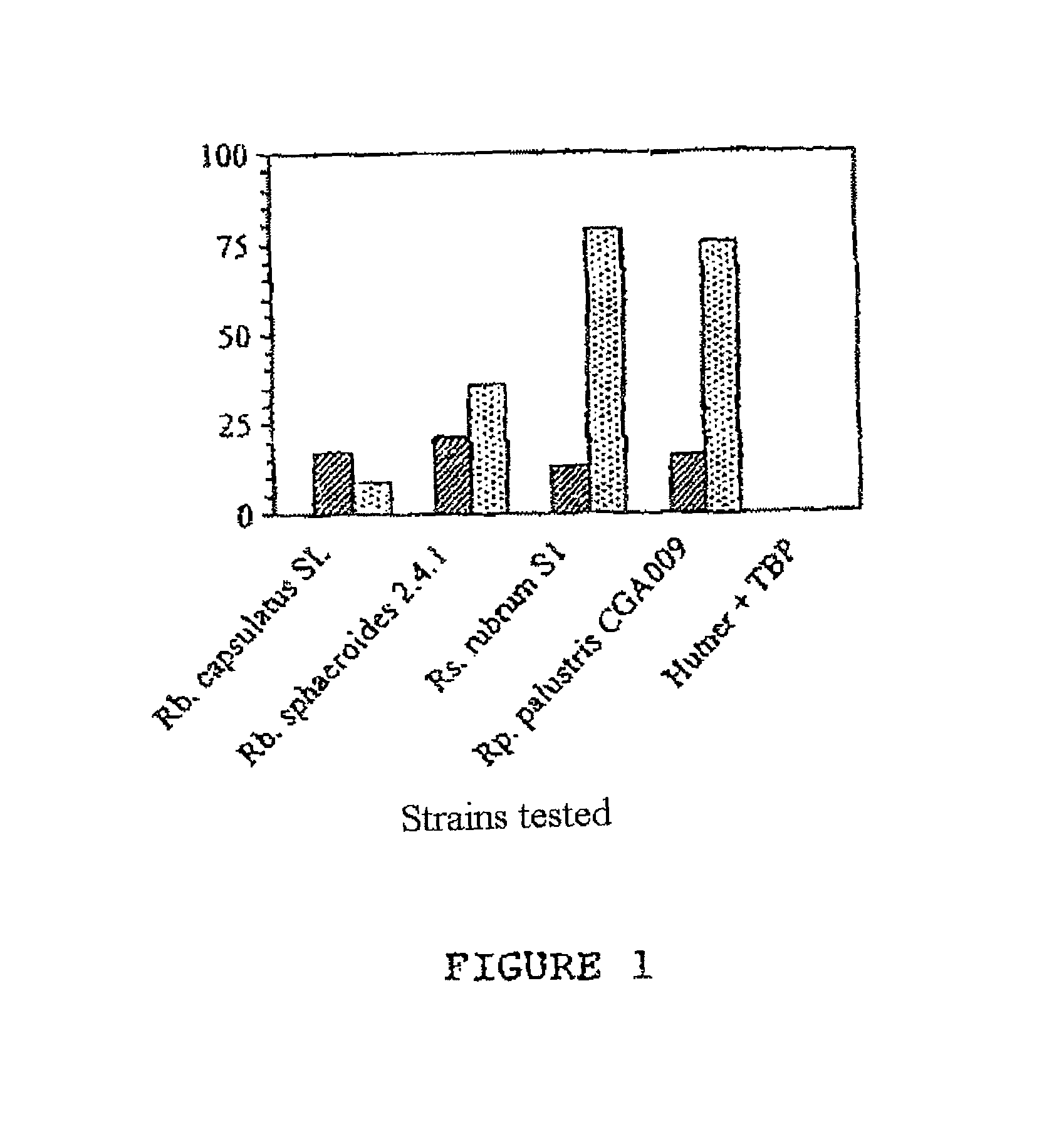Method of degrading TBP using a photosynthetic bacterial strain
a technology of photosynthetic bacteria and bacterial strain, which is applied in the field of degrading tbp using a photosynthetic bacterial strain, can solve the problems of large amount of waste, relatively non-biodegradable, ecological imbalance at the contaminated site,
- Summary
- Abstract
- Description
- Claims
- Application Information
AI Technical Summary
Benefits of technology
Problems solved by technology
Method used
Image
Examples
example 1
Comparison of the TBP Degradation Yield Under Conditions of Aerobiosis and Anaerobiosis (Microanaerobiosis or Microaerophilia) by Various Purple Non-Sulfur Photosynthetic Bacteria
A. Materials and Methods
[0071]During this experiment, the concentration of residual TBP under conditions of aerobiosis and under conditions of microanaerobiosis, after 3 weeks of culture with the following photosynthetic bacteria is measured: Rb. capsulatus Saint-Louis (ATCC 23782), Rb. sphaeroides 2.4.1 (ATCC 17023), Rs. rubrum S.1. (ATCC 11170) and Rp. palustris CGA009 (ATCC BAA-98).
[0072]The photosynthetic bacteria are incubated in a Hutner medium [6] in which the pH is between 6.5 and 7.5, in the presence of 2 mM of TBP, either under conditions of aerobiosis or under conditions of microanaerobiosis. Under conditions of aerobiosis, the bacteria are incubated in the dark at a temperature of 30° C., the culture medium being subjected to shaking (150 rpm).
[0073]Under conditions of microanaerobiosis, the bac...
example 2
Growth of the Rp. palustris CGA009 Strain and Kinetics of Degradation of TBP by the Same Strain Either Under Conditions of Aerobiosis, or Under Conditions of Microanaerobiosis, or Under Conditions of Anaerobiosis
[0082]Because of the results obtained in Example 1, the Rp. palustris strain was more particularly studied.
A. Materials and Methods
Strains and Media
[0083]The strains and the media used are given in Table I below.
[0084]
TABLE IDescription of the various plasmids andstrains used:Strain orSource orplasmidCharacteristicsareferencestrainsDH5α pheF− Φ80dlacZΔM15Δ(lacZYA-argF)U169(8)recA1 endA1 hsdR17 (rK−mK+) sup E44λ−gyrA thi-1 relA1 phe::Tn10dCmHB101F− Δ(gpt-proA)62 leuB6 supE44(7)ara-14 glaK2 lacYI Δ(mcrC-mrr)rpsL20 (Str) xyl-5 mtl-1 recA13strainswtCGA009 strain, genome completelysee above-sequencedmentionedsiteΩLH59395939 Ω with plasmid pCB07InventionΔpRpa1Derived from the strain CGA009;Inventioncomprises no endogenous plasmidPlasmidspGEM-T ®Cloning vector, AprPromegapBBR1MCS2C...
example 3
Effect of various Concentrations of TBP on the Growth of the Rp. palustris CGA009 Strain and the Kinetics of Degradation of TBP by the Same Strain Under Conditions of Microanaerobiosis
A. Materials and Methods
[0102]The culture conditions and the TBP analysis conditions are identical to those used in Example 2.
B. Results
[0103]The results are illustrated in FIG. 3.
[0104]The Rp. palustris CGA009 strain was cultured in the presence of varied concentrations of TBP: 2, 1.5, 1, 0.5 and 0.1 mM under conditions of microanaerobiosis.
[0105]According to these results, a shortening of the growth lag is noted when the TBP concentration is reduced. In addition, at a concentration of less than 1 mM, the growth of the strain is similar to that observed in the medium lacking TBP (FIG. 3A). The TBP degradation yields improve when the TBP concentration is less than 1 mM; the TBP is then almost entirely degraded in 21 days (FIG. 3B).
[0106]No inhibition of the TBP degradation by a secondary metabolite is ...
PUM
| Property | Measurement | Unit |
|---|---|---|
| temperature | aaaaa | aaaaa |
| temperature | aaaaa | aaaaa |
| concentration | aaaaa | aaaaa |
Abstract
Description
Claims
Application Information
 Login to View More
Login to View More - R&D
- Intellectual Property
- Life Sciences
- Materials
- Tech Scout
- Unparalleled Data Quality
- Higher Quality Content
- 60% Fewer Hallucinations
Browse by: Latest US Patents, China's latest patents, Technical Efficacy Thesaurus, Application Domain, Technology Topic, Popular Technical Reports.
© 2025 PatSnap. All rights reserved.Legal|Privacy policy|Modern Slavery Act Transparency Statement|Sitemap|About US| Contact US: help@patsnap.com



